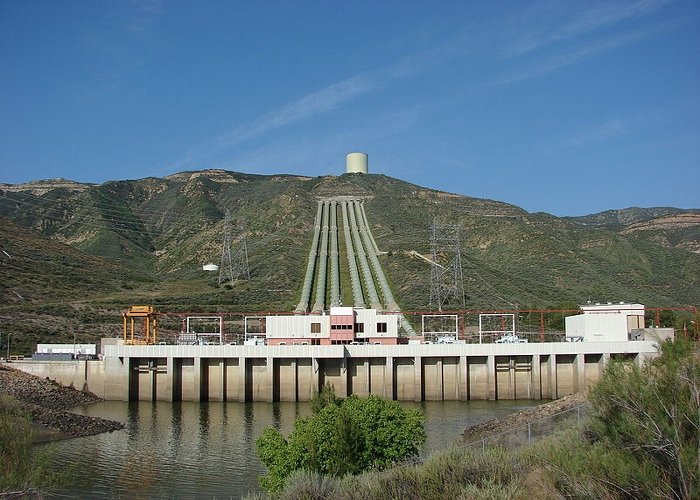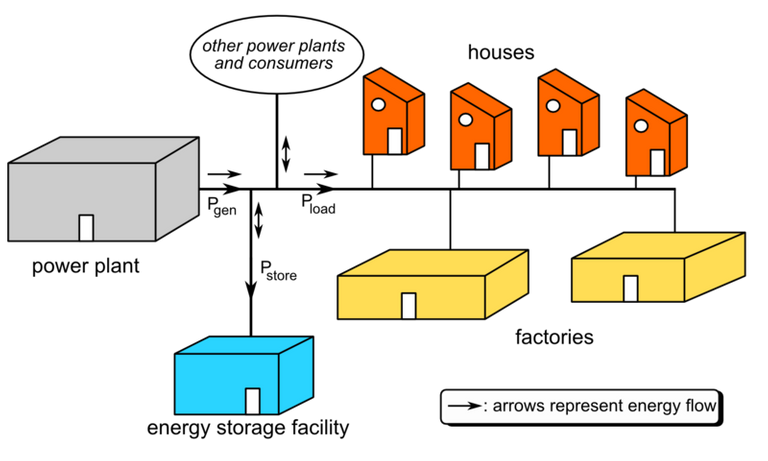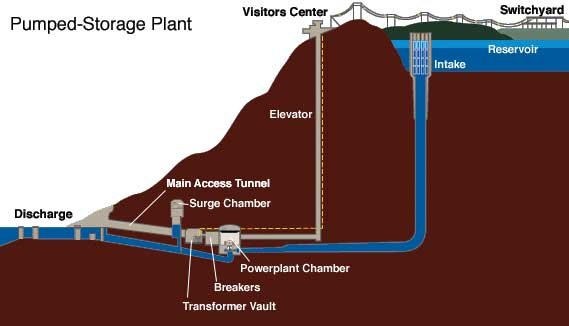Today I announce the birth of a series on Grid Energy Storage Technology. My decision to begin this series was motivated by the latest masterpiece by @mobbs. The post revealed in details the most effective approach to churning out rich and quality STEM articles, including adopting "series strategy" where the subject of interest is so verse that it would be difficult to properly address it in just one or two articles without boring your audience and leaving off vital points. Splitting the subject into several segments and using a series approach to specifically tackle each segment will ensure the subject is effectively covered to the delight of your audience and learned Guild. So even though I had long been considering a series on Grid Energy Storage Technology @mobbs' article was what gave impetus to it. And I am really excited about this series. So let's go there...

[A pumped-storage hydropower. Source: Wikimedia commons. Author: Sirbatch. CC BY-SA 3.0 licensed]
Before I dwell on today's subject — pumped hydropower — which happens to be one of the technologies of grid energy storage, it is important that we understand what grid energy storage is all about; prompting up the question: what is grid energy storage technologies?
What is grid energy storage technologies?
For sometimes now I have been writing on various means of generating renewable energy, which is, of course, the major direction where the world is headed to in order to curtail continuous dependence on fossilized sources of energy. Electrical energy can be readily generated from intermittent renewable sources like wind power, solar power, tidal power, etc. While generating electricity from sun, wind, and tides are imperative to a decarbonised future, the fact that these renewable sources are weather dependent is a major impediment to steady supply of electricity. This explains why I used the term intermittent as these sources do not generate electricity at all times; they are weather dependent and so could cause gaps in power supply.
One possible solution to this impediment is storage. By this, I mean we can actually store renewable electricity when the intermittent sources are still able to generate electricity and once they stop generating, we can then begin to utilize the stored electricity.
Hence, grid energy storage technologies can, therefore, be defined as the totality of ways by which electricity is stored on a large scale within an electrical power grid. With help of these technologies, electricity from intermittent power sources like sun, tides, wind, etc is stored during the time electrical energy production is more than its consumption by the public, and returned to power grid when consumption by the public exceeds the rate of generation ref..

[A schematic electrical grid with grid energy storage. Source: Wikipedia. Author: Wikichesterdit. CC BY 3.0 licensed]
One issue that has been militating against energy storage is developing a technology that is capable of storing electricity to a scale that is large enough to power a city. Such a tech is yet to be developed. However, much efforts are being made in this regard, and while much successes have been recorded in fabricating a number of grid storage technologies, much work is still needed to be done before we can have a technology that can store electricity to a scale large enough to power a whole city. In this series, we shall be looking at those technologies that can be used to store electricity from renewable sources. Pumped hydropower is one of such technologies, and that's what we will be considering in this particular episode.
Pumped hydropower technology
This technology is also called pumped-storage plant, pumped-storage hydroelectricity (PSH), pumped hydroelectric energy storage (PHES) or pumped hydroelectric plant. It is much like a typical/conventional hydropower dam. The only difference between a conventional hydropower plant and a pumped storage plant is: in the former, water from the reservoir makes one-way journey. After passing through and exiting the plant, it continues down stream and is never housed in a reservoir to be reused again. However, pumped hydropower makes use of two reservoirs — upper and lower reservoirs — to generate and store electrical energy in the form of gravitational potential energy of water ref..

[Diagram of a pumped storage facility. Source: Wikimedia commons. Author: Unknown. public domain licensed]
What happens in the upper reservoir is similar to what happens in a conventional hydropower dam. Here, water generates electricity when it flows through the hydropower plant. Water exiting from the hydropower plant, instead of re-entering the river and flowing downstream, is collected in the lower reservoir from where it is pumped back into the upper reservoir by the use of a reversible turbine during off-peak hours. As you can see, the lower reservoir is essentially used to refill the upper reservoir, making more water available to the plant with which to generate energy during high demand periods.
With its reservoirs, pumped-storage hydroelectric is able to hold large volumes of water and so is regarded as a large scale energy storage. It has round-trip energy efficiency that varies between 70% to 80% and accounts for 99% of the world's bulk storage capacity. Pumped-storage hydroelectric is said to be a dispatchable energy source because energy can be generated and distributed whenever there is a demand for it. It is primarily used to meet energy demands whenever non-dispatchable energy sources like sun and wind are not generating electricity.
How pumped-storage hydropower plant generates electricity
During the periods of low electricity demand, there is excess electricity from the grid. With the help of some reversible turbine/pump, the excess electricity is used to pump water up into the upper reservoir. In times of high electricity demand from consumers, the water being stored in the upper reservoir is made to flow down a slope via penstocks and then turbines where kinetic/potential energy of water is first converted to mechanical energy before eventually being converted into electrical energy by a generator.
.svg1.png)
[A cutaway view of a hydraulic turbine and electrical generator. Source: Wikipedia. Author: Gothika. Public domain licensed]
To put it in a more clear form, flowing water is channeled on to the blades of turbine to exert spinning force on it. The generator component is made up of shaft, excitor, rotor and stator, and it is attached to the turbine by shaft. As such, the spinning of turbine also causes shaft to spin too; while this is happening, electrical current is passed to the rotor from excitor. The rotor is characterized by electromagnets that spins inside a tightly coiled copper wire called stator. As turbine rotates, so also the magnets inside coils of wire. Electrical current is generated by the magnetic field between the coil and the magnets.
Conclusion
Despite pumped-storage hydropower being the largest and mainstay storage facility for renewable energy sources in the world today, there are many factors that tend to limit their applications. One such factor is its specific topographic requirement. The topographic nature of area where pumped-storage hydropower is to be constructed must be able to hold large quantity of water at a very high altitude, while, at the same time, having another reservoir that's way below the upper reservoir. For this reason, it is always very difficult to find a suitable piece of land to build pumped-storage hydropower plant.
Even when land is available, the project is not cost effective. Nevertheless, the project is very profitable because thousands of units of electricity are sold during peak hours. Thanks for reading.
References for further reading
- How energy storage is starting to rewire electricity industry
- Grid energy storage
- Pumped storage hydroelectricity
- Pumped hydroelectric storage
- Pumped storage
- How hydropower plants work
- Water turbine
Yours truly,
@eurogee
Do You Blog About Science, Technology, Engineering, and Mathematics? If Yes, Patiently Read The Below Info


Join Euronation Community on Telegram and whatsapp through the below links to socialize with larger steemit community:

No Witnesses = No Steem Blockchain; If You Truly Love Here, Vote For Witnesses NOW!
Click This Link To Vote Now


The major drawback with Hydropower is the requirement of large operating area. Which in turn takes away value land that can be used for agricultural purposes.
These pump systems will need a smaller footprint that more typical dam generation.
As an example; with 3 generators would draw water from 3 pipes during full power generation. If 2 pipes generates enough, the excess generated can be used to pump the water back to the resevoir.
In terms of having grid scale power "backup" this is one of the better options available.
Thanks for your insightful comment.
Thanks for this insight. It's a great addition!
You are most welcome.
Nicely introduced
So we are waiting to be soaked into this series...
That's really new to me.... Am in for this series
There is a lot to learn... Thanks @eurogee
Sure. Thanks
The major drawback with Hydropower is the requirement of large operating area. Which in turn takes away value land that can be used for agricultural purposes.
Great article. In the American western states, there are many attempts to do this, Nevada's Hoover Dam being the most famous example. Issues experienced at China's Three Gorges Dam are examples of the many challenges that face HydroElectric engineers.
Will be waiting for more parts of this series!
However this is an awesome one already.
Kudos @eurogee
Hydropower demands a lot to be effectively installed and managed. Thats why it still have not been widely accepted yet.
Great input. I guess your right. Thanks
Nice little write up man. You about to school us all with this series. Keep them coming
Yes boss. You rock! ✌️
Hi @eurogee!
Your post was upvoted by utopian.io in cooperation with steemstem - supporting knowledge, innovation and technological advancement on the Steem Blockchain.
Contribute to Open Source with utopian.io
Learn how to contribute on our website and join the new open source economy.
Want to chat? Join the Utopian Community on Discord https://discord.gg/h52nFrV
Wonderful thoughts !!!
Hi @eurogee!
I loved reading your article about Grid Energy Storage Technology. :)
It was a very interesting read which I will definitely going to keep it in my library collection to rad it some more times! :)
I liked the simplicity and the deep description you put in here for the deep understanding about the Grid Energy Storage Technology! :)
Wishing you a very prosperous day ahead! :)
Thanks very much. ✌️
Lovely write up.. I tried joining the whatsapp group but it says the link has been revoked
Pm me on discord. Thank you
When you write your series, you should consider including ZyncNyx, the battery technology recently purchased by MGX minerals and soon to be spun out into it's own public company. Its an incredible and scalable battery technology without any of the high cost elements or resources that will limit lithium ion batteries. You can find the information here: https://www.mgxminerals.com. I plan to write a post about it and two other investments I have put money into related to energy reduction/crypto mining...
Thanks. I will check it out
I consider that one of the most influential factors in the use of re pumping in hydroelectric plants is their cost, the cost of production is not profitable.
I think there must be a commitment to rational use between non-renewable energy and renewable energy.
Every day the use of renewable energy increases, and thermal generation units are built with less environmental impact, such as the use of combined cycle thermoelectric generation plants.
While the day comes when we can store energy, for the maximum use of renewable resources, such as the Sun, the Tides, the river flow, we must guarantee a clean, safe, reliable, continuous and quality energy supply.
Congratulations on your publication
I agree with you. Thanks
Such a nice picture . I love photography , something beautiful
Very good your post my friend
i really didnt know about the pumped hydro system until today. It really is a nice way to truly renew energy sources.
nicely written sir
Sure it is